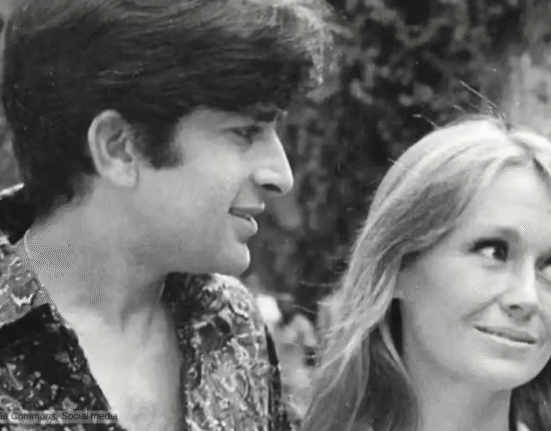Naseem Banu was one of the most beautiful faces of Hindi cinema in the 1940s, fondly called “Pari Chehra—Fairy Faced” by her fans.Some of her most memorable films include Pukar (1939), Chal Chal Re Naujawan (1944), Anokhi Ada (1948), Sheesh Mahal (1950), and Shabistan (1951). She is often called the “Beauty Queen” and the “first female superstar” of Indian cinema.
She continues, Known as “Pari Chehra,” she wasn’t just a star; she was a constellation in her own right, the first female superstar of Indian cinema. Yet, behind her charming beauty and legendary fame was a soul steeped in resilience, grace, and love.”
Saira Banu
Early Life
Naseem Banu, born on Jan 1, 1916, as Roshan Ara Begum, was a prominent figure in the Indian film industry, known for her exceptional beauty and significant contributions to cinema during the mid-1930s and mid-1950s. Her mother, Shamshad Urf Chamiyan Bai, was a classical singer from a family of performers (Mirasi). Her father, Nawab Abdul Waheed Khan of Hasanpur, came from a wealthy, aristocratic lineage.
Shamshad wanted her to focus on her studies and pursue a career in medicine. Naseem on the other hand, had a passion for films. Naeem was big fan of famous actress Sulochana (Ruby Myers). She reportedly, decided to pursue acting affter watching her movies. Naseem was studying at Queen Mary’s High School, Delhi, when, she visited Bombay in her vacations. In Bombay, she got the chance to watch a movie shoot where great filmmaker Sohrab Modi noticed her. Impressed by her beauty, he offered her the role of Ophelia. Her mother’s refusal led her to a hunger strike. Seeing her persistance, Shamshad eventually allowed her to act. She made her debut in Sohrab Modi’s “Khoon Ka Khoon” (Hamlet) in 1935.
The First Superstar
In 1938, she starred in Sohrab Modi’s Talaq (1938), with Prem Adib and Navin Yagnik. In the film she played woman, unhappy with her husband, fights for better divorce laws in country. It was a bold role for its time. She aslo acted in films like Khan Bahadur (1937), Meetha Zahar and Vasanti (1938)

Naseem Banu’s career took a significant turn with the film “Pukar” in 1939, where she portrayed the role of Empress Nur Jahan. It was a milestone in her career, establishing her as a leading actress of her time. Her dedication to the role was evident as she prepared extensively, including learning horseback riding and singing, to embody the character authentically. In the film she sang “Zindagi Ka Saaz Bhi Kya Saaz Hai” which became a hit. The film’s grand sets and her regal presence captivated audiences, earning her widespread acclaim.
The film’s success brought her widespread recognition and immense love from audience. She was affectionately dubbed “Pari-Chehra” (Fairy Face) Naseem, a testament to her enchanting beauty.
Pari Chehra
Naseem and her husband, Mian Ehsan-ul-Haq, founded Taj Mahal Pictures in the early 1940s. The first film of Taj mahal Pictures was K M Multani directed Ujala (1942). The film starring Naseem Banu, Prithviraj Kapoor and Rattan Bai was written by Kamal Amrohi. After the success of Ujala, they went on to produce films like Begum (1945), Mulaqat (1947), Chandni Raat (1949), and Ajeeb Ladki (1952).
In 1944, she acted in the Gyan Mukherji-directed “Chal Chal Re Naujawan,” opposite Ashok Kumar. The film, written by Saadat Hasan Manto, was big success. One of her other notable films was Mehboob Khan’s “Anokhi Ada (1948),” opposite Prem Adib and Surendra.
In 1950, she starred in Sohrab Modi‘s “Sheesh Mahal” with Sohrab Modi and Gajanan Jagirdar. She starred opposite superstar Shyam in “Shabistan (1951),” directed by Bibhuti Mitra. It was during the shooting of this film that Shyam fell from the horseback and died.
Naseem’s other films include Main Hari (1940), Jeevan Swapna (1946), Door Chalen (1946), Betaab (1952), Sinbad Jahazi (1952), Baghi (1953), Nausherwan-E-Adil (1957), and Chaddian Di Doli (1966).


Marriage and Later career
Naseem married her childhood friend, architect Mian Ehsan-ul-Haq, in 1940. They founded Taj Mahal Pictures together. The couple had two children: daughter Saira Banu, born in 1944, and son Sultan Ahmed, born in 1939. Sultan passed away in 2016. After the 1947 partition, Ehsan moved to Pakistan, but Naseem stayed in India with her children.
She briefly lived in England for her children’s education but returned to India, finding England too cold and aloof. Naseem played a role in arranging Saira’s marriage to Dilip Kumar in 1966, though she initially viewed Kumar as a “confirmed bachelor.”
Legacy of Naseem Banu
Naseem Banu was a trailblazer who mesmerised the audience with her beauty grace and charisma. She dominated the film industry from in the 1930s and 40s. Legends like Dilip Kumar and Amitabh Bachchan called her the most beautiful woman they had ever seen. Her influence extended beyond the silver screen, as she later turned her attention to fashion, designing intricately embroidered saris and contributing to the industry with her impeccable taste and style. She designed clothes for her daughter in many films.
“Yet, her beauty wasn’t confined to her visage. It was in the way she balanced tradition and progress. Though we were educated in London, she kept us grounded in our Desi roots.
Saira Banu
What truly defined Appaji was her devotion. Every success I have achieved is rooted in her sacrifices. She was a mother who gave not just life, but also purpose, structure, and infinite love.
Naseem Banu passed away on June 18, 2002, but her contributions to Indian cinema continue to be celebrated and remembered as a golden chapter of film history.
Naseem Banu on IMDB









